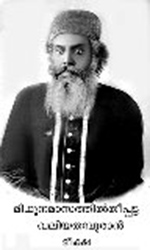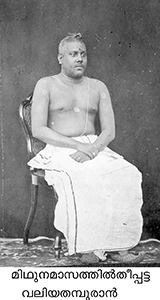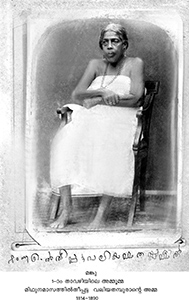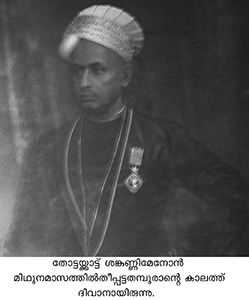Raja Rama Varma -- (Mithunamasathil theeppetta thampuran ) was the nephew of the previous Raja who died in 1864. He is the son of Manku Thampuran of Thavazhy one. The Raja is shown immediately after ascending the Gadi (throne) while he was observing the ' deeksha" or mourning period for his maternal uncle, the previous Raja. As per the tradition, he would have had to refrain from shaving or cutting hair during the mourning period of one year. The Raja is featured here in his official capacity, and in the traditional attire wearing a 'mundu'. The last picture is of his mother, Manku Thampuran ( Thavazhy one).
He gave Dewan Sankunny Menon his full support. Together they provided good administration to Cochin. A man of judicial background, Menon's first priority was to rectify the system by appointing graduates in law or barristers to higher positions in the Court replacing unqualified personnel. Vague and customary law was being replaced by English Common law.
In 1865, he was able to finalize the Interportal Trade Convention to regulate trade occurring between the British Malabar, Cochin and Travancore. The inland customs and tariffs were abolished.
He paid great attention to revenue and expenditure. He augmented the State income by the registration of deeds, revision of Court fee Regulation and the lease of forest lands for coffee cultivation. The gross receipts increased by fifty percent during his administration.
Public works received great attention and further improvements were made very much like his father Sankara Variyar. Many of the roads built by his father were metaled during Sankunni Menon’s time. Many of the important buildings were built at this time in Ernakulam. He was desirous of introducing railway but for the opposition of the Raja to borrowing money to finance the scheme.
Systematic and organized education started by Colonel Munro by establishing vernacular schools were modified from time to time and during Sankunni Menon’s period there were only two English schools in the State initially. He established English schools in each Taluk and raised the School in Ernakulam to the status of Second grade College and built substantial buildings to house these institutions. Mr. Sealy in 1865 and Mr. Cruickshank in 1874 were introduced to supervise the education. Dewan instituted scholarships for exceptional scholars who wanted to pursue Engineering or Medicine in Madras. The Public Library and reading rooms in Ernakulam was started during this time.
Publication of Cochin Government Gazette and the yearly Annual Report along with its Malayalam translation was started during his time. (The annual reports are available in the British Library in London from 1864 onwards up to 1947 catalogued IOR/V10/1031 or 1030 etc.).
Because of failing health, he decided to retire in 1879 much against the wishes of the Raja and the British Resident. The accolades he got from the Raja, the Resident and the Madras Government were superlative. Lord Salisbury, the Secretary of State for India when he submitted his report to Parliament on the “ Material and Moral Progress of India”, he wrote that “ if all native States in India were administered as was Travancore by Madhava Rao and Cochin by Sangunni Menon, the British Government would have to look to their laurels”.
Sankunni Menon was succeeded by his brother Govinda Menon. Outstanding disputes between Travancore and Cochin States were arbitrated by J.C.Hannington of Madras Civil Service. The issue of right over Idiyara range near Malayattur was
won by Travancore. As also was the right to nominate the Tachudaya Kaimal to manage the Koodalmanickam temple was afforded to Travancore. Sovereign right over certain villages near Elankunnapuzha, Annamanada and Perumanam temples were won by Cochin but the right of management were given to Travancore.
Cochin grieved the loss of control over those temples but treaties made under duress of wars of the past had to be honored.
Raja Rama Varma died in 1888, after reigning for 24 years. He is fondly remembered as the Thampuran who died in the month of Mithunam




